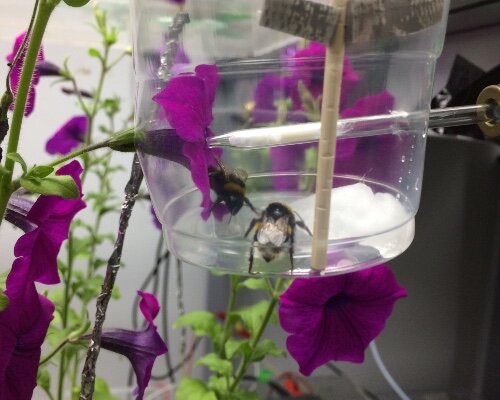
Petunia flowers are visited by bees Credit: Clara Montgomery
Recent research shows that visiting bumblebees creates an electrical charge which stimulates certain flowers to release more sweet-smelling fragrances. This is the first instance of a plant using the presence of bees as a cue for releasing more of its sweet-smelling perfume, increasing its chances of being visited.
Although pollen is believed to stick to bees during flight, a team of researchers from Cardiff University, Rothamsted Research and University of Bristol discovered that the tiny electrical charge they carry can also signal their presence to flowers.
According to Dr. Clara Montgomery (funded by the BBSRC), the trait may have evolved in plants to increase the effectiveness of the appealing chemicals they release.
These scents are limited in supply so flowers only release them when they have pollinators. It is worth advertising only if you know your audience. Some other cues that they may use, like temperature or daylight, can be unpredictable. It might also rain or windy, which could reduce the presence of pollinators.
These scents can also be used by insects to eat the plant or lay eggs. It is therefore vital that they are attracted to pollinators.
Although the electrical charge that a bumblebee receives is small, it was sufficient to cause a species violet petunia, Petunia Integrifolia to release more scent.
Petunia was touched by a charged rod. Credit: University of Bristol
The team used specially-constructed foraging arenas to measure the electric charge carried by each bee and the amount of the main attraction chemical, benzaldehyde released by flowers by bees in response to their visits.
To distinguish between the chemical stimulus of bee landing on a flower and its response to electrical stimulation, the scent release of the flowers was measured using a subset petunias that had been touched with either an electrically charged nylon ball or a grounded metal rod.
The volatile production of flowers visited by free-flying bees was significantly higher. However, flowers that were touched with an electrically grounded rod of metal did not experience such increases.
The electrically charged ball was able to produce a scent equivalent to five bee visits. It can also increase the volume of smell by touching the petunia flower.
Although pollinators are known to have positive electric charges for a long time, this is Dr. Montgomery's first demonstration that plants can use this advantage. He is currently at Harper Adams University.
Petunias in Faraday cage. Credit: University of Bristol
"Frequent visits of charged pollinators would cause charge buildup, which could exceed threshold for scent release. The charge could be used to determine the number of pollinators in the area and allow the plant to evaluate the potential for pollen dispersal.
"The current understanding of the electric charges carried in different insect species is very limited. The influence of electric fields upon all biological systems is often difficult to quantify and poorly understood."
Professor Daniel Robert, University of Bristol's project leader, stated: "This discovery uncovers a previously undiscovered type of interaction between plants and insects, a world of mysterious electric cues that we humans cannot detect."
He also highlighted the unique value of multidisciplinary collaborations between Rothamsted scientists and the University of Bristol. This includes chemical ecologists as well as plant physiologists, bee sensory ecologists, and plant physiologists.
"Insects provide pollination services to many of our crops and are the most dominant pollinators within agroecosystems. "The better we understand the interactions between pollinators and plants, the more we can preserve pollinators and ensure food security," said Dr. Jzsef Vats, Rothamsted chemical ecologist and co-author.
Montgomery, C.Vuts, J. Woodcock, C.M., "Bumblebee's electric charge stimulates floral volatile emission in Petunia Integrifolia but it is not in Antirrhinum major," The Science of Nature publishes et al.
Continue reading The invisible attraction of flowers to bumblebees is the humidity
Clara Montgomery and colleagues, Bumblebee's electric charge stimulates flower volatile emissions in Petunia Integrifolia, but not in Antirrhinum majorus, The Science of Nature (2021). Clara Montgomery and colleagues, Bumblebee's electric charge stimulates floral volatile emission in Petunia Integrifolia but not Antirrhinum major, (2021). DOI: 10.1007/s00114-021-01740-2
